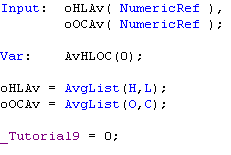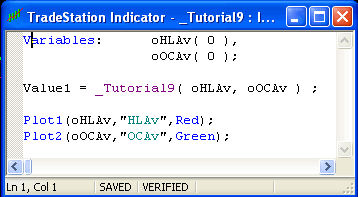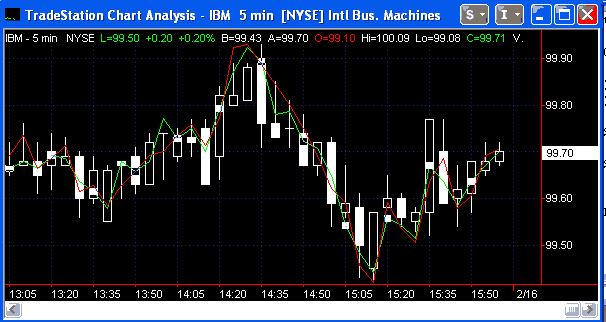Welcome to tutorial 9 in this series of tutorials designed to introduce basic EasyLanguage concepts.
TO THE BEST OF MARKPLEX CORPORATION’S KNOWLEDGE, ALL OF THE INFORMATION ON THIS PAGE IS CORRECT, AND IT IS PROVIDED IN THE HOPE THAT IT WILL BE USEFUL. HOWEVER, MARKPLEX CORPORATION ASSUMES NO LIABILITY FOR ANY DAMAGES, DIRECT OR OTHERWISE, RESULTING FROM THE USE OF THIS INFORMATION AND/OR PROGRAM(S) DESCRIBED, AND NO WARRANTY IS MADE REGARDING ITS ACCURACY OR COMPLETENESS. USE OF THIS INFORMATION AND/OR PROGRAMS DESCRIBED IS AT YOUR OWN RISK.
ANY EASYLANGUAGE OR POWERLANGUAGE TRADING STRATEGIES, SIGNALS, STUDIES, INDICATORS, SHOWME STUDIES, PAINTBAR STUDIES, PROBABILITYMAP STUDIES, ACTIVITYBAR STUDIES, FUNCTIONS (AND PARTS THEREOF) AND ASSOCIATED TECHNIQUES REFERRED TO, INCLUDED IN OR ATTACHED TO THIS TUTORIAL OR PROGRAM DESCRIPTION ARE EXAMPLES ONLY, AND HAVE BEEN INCLUDED SOLELY FOR EDUCATIONAL PURPOSES. MARKPLEX CORPORATION. DOES NOT RECOMMEND THAT YOU USE ANY SUCH TRADING STRATEGIES, SIGNALS, STUDIES, INDICATORS, SHOWME STUDIES, PAINTBAR STUDIES, PROBABILITYMAP STUDIES, ACTIVITYBAR STUDIES, FUNCTIONS (OR ANY PARTS THEREOF) OR TECHNIQUES. THE USE OF ANY SUCH TRADING STRATEGIES, SIGNALS, STUDIES, INDICATORS, SHOWME STUDIES, PAINTBAR STUDIES, PROBABILITYMAP STUDIES, ACTIVITYBAR STUDIES, FUNCTIONS AND TECHNIQUES DOES NOT GUARANTEE THAT YOU WILL MAKE PROFITS, INCREASE PROFITS, OR MINIMIZE LOSSES.
In tutorial 8, I introduced functions. Functions are extremely useful for performing calculations that you might need to use in future EasyLanguage strategies or indicators that you may create. By using functions, you do not need to keep rewriting parts of your programs that you use frequently. Functions can also be helpful because they take a portion of your EasyLanguage code out of a ‘main’ program into a function. By doing this they make the program easier to read and understand. If you missed tutorial 8, or would like to review other tutorials in this series, they are available on my Web site at tutorials.
Please note that ANY EASYLANGUAGE TRADING STRATEGIES, INDICATORS, SHOWME STUDIES, PAINTBAR STUDIES, PROBABILITYMAP STUDIES, ACTIVITYBAR STUDIES, FUNCTIONS (AND PARTS THEREOF) AND ASSOCIATED TECHNIQUES INCLUDED IN OR ATTACHED TO THIS TUTORIAL ARE EXAMPLES ONLY, AND HAVE BEEN INCLUDED SOLELY FOR EDUCATIONAL PURPOSES. MARKPLEX CORPORATION. DOES NOT RECOMMEND THAT YOU USE ANY SUCH TRADING STRATEGIES, INDICATORS, SHOWME STUDIES, PAINTBAR STUDIES, PROBABILITYMAP STUDIES, ACTIVITYBAR STUDIES, FUNCTIONS (OR ANY PARTS THEREOF) OR TECHNIQUES. THE USE OF ANY SUCH TRADING STRATEGIES, INDICATORS, SHOWME STUDIES, PAINTBAR STUDIES, PROBABILITYMAP STUDIES, ACTIVITYBAR STUDIES, FUNCTIONS AND TECHNIQUES DOES NOT GUARANTEE THAT YOU WILL MAKE PROFITS, INCREASE PROFITS, OR MINIMIZE LOSSES.
One of the limitations of the function we created in tutorial8 was that it only returns only one value. In this tutorial we will enhance the function to enable it to return two values: the average of high and low and the average of open and close for the current bar.
Step 1
Open the function that was created in tutorial 8. Modify the function to look like the following screen grab:

There are a couple of things to notice in this new function. Firstly, the means by which EasyLanguage returns multiple vales in a function is to create ‘dummy’ inputs – in this case, oHLAv and oOCAv. These inputs will receive the value that we calculate and pass the information back to the indicator, ShowMe, PaintBar or other EasyLanguage program that calls the function. Notice that the inputs have the (Numericref) to designate them as things that will return values. The other thing to notice is that we still need to return a value to the name of the function. We could have used a ‘meaningful’ value here, however I have returned the value 0. If you miss the _Tutorial9 = 0 line then you will receive an error when you try to verify the function.
Step 2
The next step is to create an indicator to use the function. Enter the following:

Notice the line:
Value1 = _Tutorial9( oHLAv, oOCAv );
This line assigns values from the function to oHLAv and oOCAv. In order to use these variables we have to create variables as follows:
Variables: oHLAv( 0 ), oOCAv( 0 );
Step 3
Once the indicator and the function have been created it is time to apply the indicator to a chart. Apply this indicator to a chart and drag and drop the indicator into the main chart. You should see something like the following;

Summary
This tutorial demonstrates the method by which multiple values can be returned from a function. Functions can really help as our programs become increasingly complex.
If you have any questions about the above material or you would like to point out a correction or typo, please e-mail: tutorials@markplex.com.

